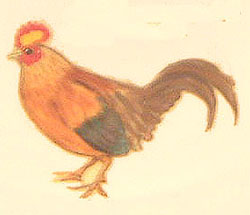Sri Lanka Junglefowl
|
|
| Sri Lanka Junglefowl | ||||||||||||||
|---|---|---|---|---|---|---|---|---|---|---|---|---|---|---|
 | ||||||||||||||
| Scientific classification | ||||||||||||||
| ||||||||||||||
| Binomial name | ||||||||||||||
| Gallus lafayetii Lesson, 1831 |
The Sri Lanka Junglefowl, Gallus lafayetii, is a member of the pheasant family which is endemic to Sri Lanka. It is a close relative of the Indian Red Junglefowl, Gallus gallus, the wild junglefowl from which the chicken was domesticated.
These are large birds, with colourful male plumage, but are sometimes difficult to see in the denser woodlands. It is common in forest and scrub habitats, and can usually be seen at sites such as Kitulgala, Yala and Sinharaja
This is one of four species of bird in the genus Gallus. It is a ground nesting bird, which lays 2-4 eggs in a nest. As with many birds in the pheasant family, the colourful male plays no part in the incubation of the eggs or rearing of the precocial young. These duties are performed by the drab and well-camouflaged female.
The male Sri Lanka Junglefowl ranges from 66-73 cm long. It is chicken-like in structure, and has orange-red body plumage, and dark purple wings and tail. The back of the head and the neck are golden, and the face has bare red skin and wattles. The comb is red with a yellow centre. Unlike other junglefowl, the cock does not have an eclipse plumage.
The female is much smaller, at only 35 cm. She is mainly brown with white patterning on the lower belly and breast.
Like most of the pheasant family, Sri Lanka Junglefowl is a terrestrial species. It scratches vigorously for various seeds, fallen fruit and insects.
References
- Birds of India by Grimmett, Inskipp and Inskipp, ISBN 0-691-04910-6de:Ceylonhuhn
